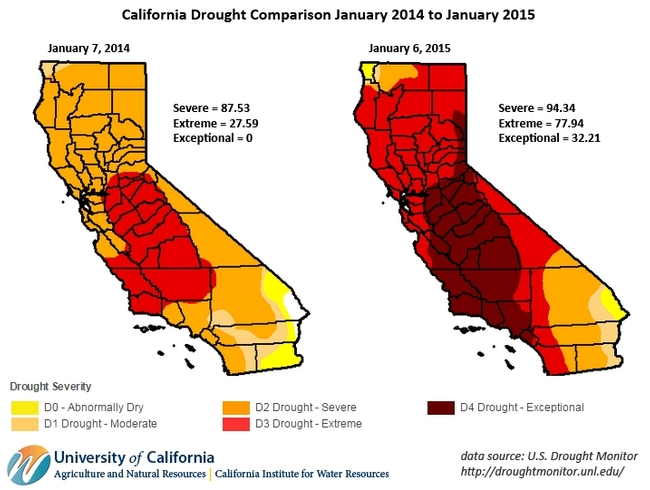Five facts that make the California drought a complex problem
“Even recent large storms, while welcome, have not made much of a dent in the state's water deficit after several hot, dry years. This drought, ongoing for three years and counting, presents several complex, important issues,” writes Faith Kearns, Ph.D., a water analyst for the UC Agriculture and Natural Resources' California Institute for Water Resources.
So what makes dealing with drought in California so complex?
Kearns has written “5 Key Facts about the California Drought—and 5 Ways We're Responding to It” to provide some answers to that question.
- California's depends on water from the winter snowpack to get through California's dry summers.
- Lynn Ingram, professor in the Department of Earth and Planetary Science at the University of California, Berkeley found that the state has previously experienced periods of prolonged drought and may be entering another dry period.
- Global climate change seems to be exacerbating the drought.
- Pumping groundwater to compensate for the shortage of surface water for agriculture has softened the economic impact of the drought, but is having detrimental effects on residents whose wells have dried up. Groundwater depletion is also causing land to sink.
- People and animals are suffering. “Some areas of the state where people have been the hardest hit are also the poorest, creating cumulative stressors and threatening livelihoods,” writes Kearns. “Furthermore, wildlife and ecosystems have been severely impacted by the drought.”
She also writes about five ways California is dealing with the drought: through legislation, spending on water projects such as water storage, reducing reliance on water transfers from other regions, managing water more efficiently and raising community awareness.
“The state's universities have been holding workshops and offering training opportunities for communities hit hard by drought, agriculture and ranching,” Kearns writes. “People are starting to realize the scale of change necessary and are joining together in non-traditional alliances.”
You can read Kearns' complete drought article on Hippo Reads.
The Public Policy Institute of California is holding a conference on managing drought on January 12 in Sacramento. The event, supported by the California Water Foundation, will bring together university researchers, legislators, farmers, environmentalists, regulators and other stakeholders together to discuss the drought, water management and policy. To register for the event webcast, visit http://www.ppic.org/main/event.asp?i=1623. You can follow the conference on Twitter with the hashtag #ppicwater.
For a list of UC drought resources and upcoming events, visit http://ucanr.edu/drought. You can follow the California Institute for Water Resources on Twitter@ucanrwater.


